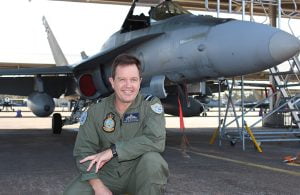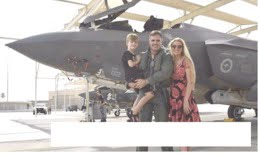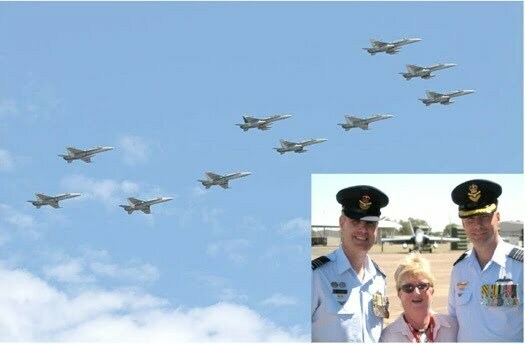During our visit to Australia in March 2018, we had a chance to get an update on the next round of modernization of the RAAF which is driven by the F-35, the operation of the Growler and the incorporation of the new robotic boom into the KC-30A as well as software upgrades to the Wedgetail supporting all of the above.
We visited Williamtown airbase which is the lead base for standing up the F-35 in the RAAF, and discussed the standup with head of the Air Commodore Kitcher, head of the Air Combat Group. One of his responsibilities is the transition at Williamtown from Hornets to the F-35 in the near future.
We will publish our interview with the Air Commodore in the near future in which he discussed the transition of the RAAF from the standpoint of ACG and the introduction of the F-35.
As Murielle Delaporte noted in a forthcoming article leveraging her time at Williamtown as part of the SLD team:
“The RAAF has gone through significant transition as the C-17, KC-30A, Super Hornet and Wedgetails have all already been added to the force over the past few years.
“The air combat capability for the RAAF required rapid and significant change and the RAAF is leveraging that experience as it shifts from a legacy to a next-generation fighter force.
“The pace of transformation is rather breathtaking: if you thought that the five past years brought quite a change, wait to see what the next three years are about to bring about!”
A recent article by Andrew Tillett, published by the Financial Review, looked at the F-35 coming closer to entering service with the RAAF.
Commander Air Combat Group Air Commodore Michael Kitcher said while there had been delays, Australia’s aircraft were being delivered on time and pilots liked what they experienced.
“The best way I can describe the capability of the aircraft is there are a lot of people who have never flown the aircraft that might choose to be purported experts on it,” he said.

“But when I talk to the aircrew that fly the aircraft there is nothing but praise for its capabilities and the fact that it is a step change in capability from anything else we’ve got.
“The jet is performing well [but] that is not to say there are no challenges. It is still a new aircraft being introduced but I believe we understand the nature of most of those challenges and are working through them.
“The guys talk about the fact they will go flying and they will do things as a two-ship and four-ship F-35s (missions) they would not even dream about doing with the classic Hornet or Super Hornet, and achieve kill-ratios that you could not replicate in other non-fifth generation platforms.”
And further insight has been provided by a recent version of 3rd Squadron news concerning the shift from the Hornets to the F-35. In a note written by Wing Commander Darren Clare, the new Commander of No. 3 squadron:
Welcome to 2018!
This is a significant time for 3 Squadron, as we continue the transition from the F/A-18 Hornet to the F-35A Lightning II.
I was fortunate enough to make it home to Williamtown for our Change of Command on 14 December last year, where WGCDR (now Group Captain) John Haly officially handed over the Squadron to me. I would like to take this opportunity to congratulate 3 Squadron ‘Hornet’ and GPCAPT Haly for their outstanding contribution to the defence of Australia, and to also congratulate them for being awarded the Kittyhawk Trophy for being the most effective 81 Wing Fighter Squadron for 2017.
Returning immediately to Phoenix the following day, we held a small function to recognise the standing-up of “3 Squadron F-35A”, and I had the fantastic opportunity, in my first official act as Commanding Officer, to promote seven of the team over here. This had been kept as a surprise for them and, I think, happening right around Christmas was an added bonus.
The next significant milestone for us here will be the arrival of aircraft AU-003 in early February – the first aircraft bearing 3 Squadron markings [pictured above]. It will go into service initially with the 61st Fighter Squadron here at Luke AFB (our host squadron) and will be the Squadron’s first 3F Software aircraft, which brings with it some great enhancements in capability.
Following aircraft AU-003, seven more F-35A aircraft will enter service this year – two of which will return to Australia with us at the end of the year.
It is truly a privilege to take command of such a fine Squadron, and I look forward to updating you as we continue our transition.
The Wing Commander then recalled his first flight on the F-35A.
“The jet feels very similar to a Hornet in most flight regimes and it was exciting to take-off in the airplane for the first time solo. The Operations and Maintenance Teams made sure I flew an Australian aircraft for the flight, and I was also launched by an Aussie ‘Crew Chief’, which made it all the more special.
The F-35A is a lot more powerful, especially at low level. The ‘Helmet Mounted Display’ takes a little bit of getting used to. It’s similar to the one used in the Hornet and Super Hornet [‘Joint Helmet Mounted Cueing System’].

If looking out the side of your cockpit, however, you need to physically face the front to see the [virtual] Head-Up Display for flight vector information, which in the Hornet is presented on a physical HUD.
The sensors and datalinks are pretty amazing, giving the pilot a very good awareness of what is going on around them, both in the air and on the ground. This is driving us to a philosophical change in how we fly; operating far more autonomously than in previous aircraft.
A graduate from the F-35A Operational Conversion course is going to be making far more tactical decisions (given the amount of information that they have) than we would have expected from a Hornet graduate in the past. This will be just one of the changes in how fighter flying will adjust as we introduce the F-35A Lightning II.
I can see the momentum building, and our people will be ready when Air Force receives its next eight F-35As in 2018, as the transition hits full swing.”
The editor for the 3rd Squadron newsletter provided this update as well:
The team charged with bringing home Australia’s F-35A Lightning II in December 2018 has now passed important milestones, with dozens of maintenance crew having completed their technical training.
SQNLDR Leigh TINKER, Senior Engineering Officer for the F-35A Transition Team, announced late in 2017 that he now has a trained cadre of personnel stationed at Luke Air Force Base, Arizona, after initial maintenance training was completed at Eglin Air Force Base [Florida].
A number of maintenance personnel – many ex-3SQN Hornet – have returned to Australia to prepare for the arrival of the aircraft at the rebuilt RAAF Base Williamtown.
Most of them will form the core of the revitalised No.3 Squadron when it stands up as the Royal Australian Air Force’s FIRST Operational F-35A Squadron, with other technicians posted to No.2 Operational Conversion Unit (co-located at Williamtown).
The caption provided by the editor of the 3rd squadron newsletter for the lead photo above was as follows:
The magnificent ceremonial “3-Formation”, flown on 8 Dec 2017, marking the LAST official operation of the Hornets of 3SQN.
Inset: On Thursday 14th December, command of the Squadron officially passed to the new “CO3”, WGCDR Darren CLARE. Seen here with Vicki Crighton and the freshly-promoted [and much-acclaimed!] GPCAPT Johnny HALY.]
The RAAF process of change was highlighted by Ed Timperlake’s piece published in 2016 highlighting the key role of squadron pilots in driving combat innovation in the combat force.


